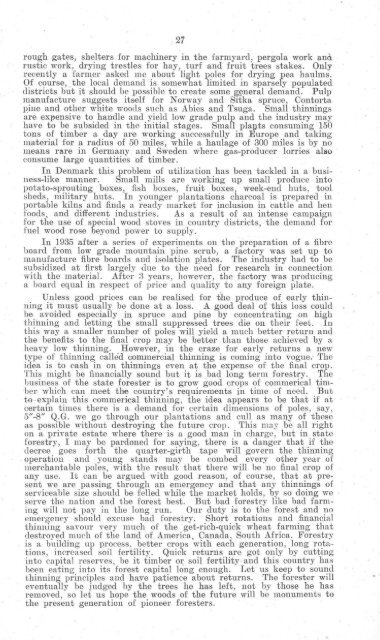Download Full PDF - 19.3 MB - The Society of Irish Foresters
Download Full PDF - 19.3 MB - The Society of Irish Foresters
Download Full PDF - 19.3 MB - The Society of Irish Foresters
You also want an ePaper? Increase the reach of your titles
YUMPU automatically turns print PDFs into web optimized ePapers that Google loves.
27<br />
rough gates, shelters for machinery in the farmyard, pergola work and<br />
rustic work, drying trestles for hay, turf and fruit trees stakes. Only<br />
recently a farmer asked me about light poles for drying pea haulms.<br />
Of course, . the local demand is somewhat limited in sparsely populated<br />
districts but it should be possible to create some g~ll1eral demand. Pulp<br />
manufacture suggests itself for Norway and Sitka spruce, Contorta<br />
pine and other white woods such as Abies and Tsuga. Srnall thinnings<br />
are expensive to handle and yield low grade pulp and the industry may<br />
have to be subsided in the iliitial stages. Small plap.ts consuming 150<br />
tons <strong>of</strong> timber a day are working successfully in Europe and taking<br />
material for a radius <strong>of</strong> 50 miles, while a haulage <strong>of</strong> 300 miles is by no<br />
means rltre in Germany and Sweden where gas-producer lorries also<br />
consume large quantities <strong>of</strong> timber.<br />
In Denmark this problem <strong>of</strong> utilization has been tackled in a business-like<br />
manner. Small mills are working up small producc into<br />
potato-sprouting boxes, fish boxes, fruit boxes week-end huts, tool<br />
sheds, military huts. In younger plantations charcoal is prepared in<br />
portable kilns and finds a ready market for inclusion in cattle and hen<br />
foods, and different industries. As a result <strong>of</strong> an intense campaign<br />
for the use <strong>of</strong> special wood stoves in country districts, the demand for<br />
fuel wood rose beyond power to supply.<br />
In 1935 after a series <strong>of</strong> experiments on the preparation <strong>of</strong> a fibre<br />
board from low grade mountain pine scrub, a factory was set up to<br />
manufacture fibre boards and isolation plates. <strong>The</strong> industry had to be<br />
subsidized at first largely due to the need for research in connection<br />
with the material. After 3 years, however, the factory was producing<br />
a board equal in respect <strong>of</strong> price' and quality to any foreign plate.<br />
Unless good prices can be realised for the produce <strong>of</strong> early thinning<br />
it must usually be done at a loss. A good deal o~ this loss could<br />
be avoided especially in spruce and pine by concentrating on high<br />
thinning and letting the small suppressed trees die on their feet. In<br />
this way a smaller number <strong>of</strong> poles will yield a much better return and<br />
the benefits to the final ('rap may be better than those achieved by a<br />
heavy low thinning. However, in the craze for early returns a new<br />
type <strong>of</strong> thinning called commercial thinning is coming into vogue; 'fhe<br />
idea is to cash in on thinnings even at the expense <strong>of</strong> the final crop.<br />
This might be financially sound but it is bad long term forestry. <strong>The</strong><br />
business <strong>of</strong> the state forester is to grow good crops <strong>of</strong> commerical timber<br />
which can meet the country's requil'ements in time <strong>of</strong> need. But<br />
to explain this commerical thinning, the idea appears to be that if at<br />
certain times there is a demand for certain dimensions <strong>of</strong> poles, say,<br />
5" -8" Q.G. we go through out plantations and cull as many <strong>of</strong> these<br />
as pos·sible without destroying the future crop. This may be all right<br />
on a private estate where there is a good lllall in charge, but in state<br />
forestry, I may be pardoned for saying, there is a danger that if the<br />
llecree goes forth the quarter-girtll .tape will govern the thinning<br />
operation and young stands may be combed every other year <strong>of</strong><br />
merchantable poles, with the result that there will be :no final crop <strong>of</strong><br />
any use. It can be argued with good reason, <strong>of</strong> course, that at present<br />
we are passing through an emergency and that any thinnings <strong>of</strong><br />
serviceable size should be felled while the market holds, by so doing "-e<br />
serve the nation and the forest best. But bad forestry like bad farming<br />
will not pay in the long run. Our duty is to the forest and no<br />
emergency should excuse bad forestry. Short rotations and financial<br />
thinning savour very much <strong>of</strong> the get-rich-quick wheat farming that<br />
destroyed much <strong>of</strong> the land <strong>of</strong> America, Canada, South Africa. Forestry<br />
is a building up process, better crops with each generation, long rotations,<br />
increased soil fertility. Quick returns are got only by cutting<br />
into capital reserves, be it timber or soil fertility and this country has<br />
been eating into its forest capital long enough. Let us keep to sound<br />
thinning principles and have patience about returns. <strong>The</strong> forester will<br />
eventually be judged by the trees he has left, not by those he has<br />
removed, so let us hope the woods <strong>of</strong> the future will be monuments to<br />
the present generation <strong>of</strong> pioneer foresters.

















